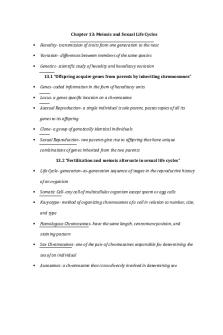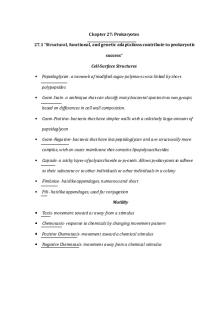Campbell Biology 11th edition chapter 30 summary PDF

| Title | Campbell Biology 11th edition chapter 30 summary |
|---|---|
| Author | Laura Ramos |
| Course | Biology Science Maj II (lec + Lab) HNS |
| Institution | Tarrant County College |
| Pages | 4 |
| File Size | 77.3 KB |
| File Type | |
| Total Downloads | 38 |
| Total Views | 141 |
Summary
This is a chapter summary ...
Description
Laura Ramos BIOL 1407 Professor Byrd
Plants Diversity II: The Evolution of Seed Plants
The Seed is the main reproductive organ of the great majority of the terrestrial and aquatic superior plants. This plays a fundamental role in the renewal, persistence, and dispersion of plant populations, the regeneration of forests and ecological succession. In nature, the seed is a source of staple food for many animals. Also, through agricultural production, the seed is essential for the human being, whose main food consists of seeds, directly or indirectly, that also serve as food for several domestic animals. The seed is one of the main resources for agricultural and forestry management of plant populations, for reforestation, for the conservation of plant germplasm and the recovery of valuable overexploited species. Seeds can be stored alive for long periods, thus ensuring the preservation of valuable plant species and varieties. The seed is a complex reproductive unit, characteristic of the superior vascular plants, which is formed from the vegetable ovum, usually after fertilization. It is found in flowering plants (angiosperms) and gymnosperms. In angiosperms the ovules develop inside an ovary; while in gymnosperms the structure that contains them is very different since it does not constitute a true flower; However, the structure of the seeds of these plants is similar to that of flowering plants. the ontogeny of the seed, that is, its formation and development, requires some knowledge of the structure of the flowers and the male and female reproductive organs. Generally speaking, the flowers consist of several layers of modified leaves that constitute, of outside in, sepals, petals, stamens, and ovary. There are large variations between species in the shape, size, and arrangement of these structures. Some plants produce flowers with separate sexes, either male
Laura Ramos BIOL 1407 Professor Byrd
with stamens or female with ovaries. The stamens produce pollen grains that contain the male gametes, and the ovary contains the ovules that will produce the seeds. The ovules of the upper floors are relatively complex multicellular structures. Inside, the ovule contains the embryonic sac and this, in turn, contains several haploid cells, not delimited, the number of which varies between different taxonomic groups. There is a certain parallel in the development of seeds in higher plants and the development of fetuses in mammals. In both cases, there is a placental type connection that transfers resources for the development of the embryo, which increases its chances of survival after separation from the mother, during germination and early stages of establishment. The main difference is that this separation, in the case of animals, is carried out by the movement of the offspring itself, while in plants, the removal of the descendants of the mother plant occurs passively and with frequency aided by external agents such as wind, water, and animals that are responsible for disseminating the seeds. In this function the ovary has an important role since it often becomes the structure that will allow the dispersion of the seed, either forming a fleshy fruit, a structure in the form of wings or hairs, or a dried fruit that when dehydrated, it opens abruptly, expelling the seeds. In some cases, parts of the fruit may become part of the seed covers, such as grasses and some fruits such as peaches. In summary, a mature seed contains tissues originated directly from the mother plant and tissues formed by the new genetic combination produced by fertilization.
Laura Ramos BIOL 1407 Professor Byrd
The first angiosperm fossils come from the Secondary era, from the Lower Cretaceous, so it is inferred that they should have appeared in the Triassic or Jurassic era. These are pollen grains similar to gymnosperms and remnants of whole and parallel leaves. Later the leaves appear with pinnate and pinnate nerve. They had to originate in the tropics and then they would compete and gradually displace tree ferns and gymnosperms in large areas of both hemispheres until almost extinguishing the cytoid and ginkgolides.
The evolutionary advantages of angiosperms derive from their greater reproductive efficacy:
- Hermaphrodite flowers, smaller. - More economical pollination (without so much loss of resources: pollen and reserve tissue of unfertilized ovules) and effective (zoidogamic) - Greater speed and efficiency in fertilization - Protection of seminal primordia inside carpels - Pollen grains with cement pollinic
The gymnosperms name that vascular plants receive that form seeds but lack flowers. They comprise several groups: cycadophytes, ginkgo’s, conifers, and gnetophytes. Gymnosperms are woody, bushy, arboreal or, more rarely, climber plants (some gnetophytes). They differ from the other edge of plants with seeds, the one formed by flowering plants (Angiosperms), in that the seeds are not enclosed in carpels, but arranged on scales organized in cones. Gymnosperms are the oldest seed plants; apparently, they come from ferns of the Devonian. The cycadophytes retain the most primitive characters of the current plants with seeds. Morphological and
Laura Ramos BIOL 1407 Professor Byrd
molecular tests suggest that gnetophytes share a common ancestor with flowering plants. Living gymnosperms are distributed all over the world, but prefer, in particular, conifers, temperate and subarctic regions. Cycadophytes and gnetophytes are primarily tropical and subtropical. How do gymnosperms reproduce? Let's analyze the life cycle of pine, one of the gymnosperms best known to all of us. The pines belong to the subgroup of conifers. In the life cycle of these plants, the tree corresponds to the sporophytes 2n generation and the gametophytes n consist of a small number of cells that originate in the sporophyte. All conifers produce two types of spores that develop in male and female pineapples or cones. Male cones are smaller than female cones and are found in the lower branches of the tree. Female cones are located in the highest branches. The female cones are formed by woody leaves that have cells in their bases
Description of angiosperms: The most characteristic element of angiosperms is the flower; whose function is to ensure the reproduction of the plant through the formation of seeds. The flowers are highly modified leaves, formed by four fundamental parts arranged in independent series, or verticils, that grow at the apex of specialized stems. The external verticil is the calyx, or set of sepals, which are modified leaves, or bracts, almost always green. Next comes the corolla, formed by the petals; these are also modified leaves, but usually with a finer texture and more vivid color. The third verticil corresponds to stamens, pollen-forming pieces, which together constitute the androecium or male portion of the flower. The innermost whorl is gynoecium, formed by carpels, the female structures responsible for forming the seeds; Carpels usually melt into a structure called style, ending in a free end called stigma....
Similar Free PDFs

Ch26 - Summary Campbell Biology
- 6 Pages
Popular Institutions
- Tinajero National High School - Annex
- Politeknik Caltex Riau
- Yokohama City University
- SGT University
- University of Al-Qadisiyah
- Divine Word College of Vigan
- Techniek College Rotterdam
- Universidade de Santiago
- Universiti Teknologi MARA Cawangan Johor Kampus Pasir Gudang
- Poltekkes Kemenkes Yogyakarta
- Baguio City National High School
- Colegio san marcos
- preparatoria uno
- Centro de Bachillerato Tecnológico Industrial y de Servicios No. 107
- Dalian Maritime University
- Quang Trung Secondary School
- Colegio Tecnológico en Informática
- Corporación Regional de Educación Superior
- Grupo CEDVA
- Dar Al Uloom University
- Centro de Estudios Preuniversitarios de la Universidad Nacional de Ingeniería
- 上智大学
- Aakash International School, Nuna Majara
- San Felipe Neri Catholic School
- Kang Chiao International School - New Taipei City
- Misamis Occidental National High School
- Institución Educativa Escuela Normal Juan Ladrilleros
- Kolehiyo ng Pantukan
- Batanes State College
- Instituto Continental
- Sekolah Menengah Kejuruan Kesehatan Kaltara (Tarakan)
- Colegio de La Inmaculada Concepcion - Cebu














